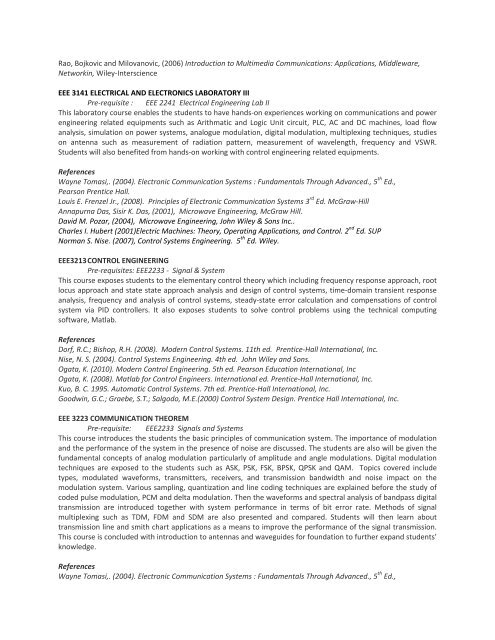JABATAN KEJURUTERAAN ELEKTRIK DAN ELEKTRONIK
JABATAN KEJURUTERAAN ELEKTRIK DAN ELEKTRONIK
JABATAN KEJURUTERAAN ELEKTRIK DAN ELEKTRONIK
You also want an ePaper? Increase the reach of your titles
YUMPU automatically turns print PDFs into web optimized ePapers that Google loves.
Rao, Bojkovic and Milovanovic, (2006) Introduction to Multimedia Communications: Applications, Middleware,<br />
Networkin, Wiley‐Interscience<br />
EEE 3141 ELECTRICAL AND ELECTRONICS LABORATORY III<br />
Pre‐requisite : EEE 2241 Electrical Engineering Lab II<br />
This laboratory course enables the students to have hands‐on experiences working on communications and power<br />
engineering related equipments such as Arithmatic and Logic Unit circuit, PLC, AC and DC machines, load flow<br />
analysis, simulation on power systems, analogue modulation, digital modulation, multiplexing techniques, studies<br />
on antenna such as measurement of radiation pattern, measurement of wavelength, frequency and VSWR.<br />
Students will also benefited from hands‐on working with control engineering related equipments.<br />
References<br />
Wayne Tomasi,. (2004). Electronic Communication Systems : Fundamentals Through Advanced., 5 th Ed.,<br />
Pearson Prentice Hall.<br />
Louis E. Frenzel Jr., (2008). Principles of Electronic Communication Systems 3 rd Ed. McGraw‐Hill<br />
Annapurna Das, Sisir K. Das, (2001), Microwave Engineering, McGraw Hill.<br />
David M. Pozar, (2004), Microwave Engineering, John Wiley & Sons Inc..<br />
Charles I. Hubert (2001)Electric Machines: Theory, Operating Applications, and Control. 2 nd Ed. SUP<br />
Norman S. Nise. (2007), Control Systems Engineering. 5 th Ed. Wiley.<br />
EEE3213 CONTROL ENGINEERING<br />
Pre‐requisites: EEE2233 ‐ Signal & System<br />
This course exposes students to the elementary control theory which including frequency response approach, root<br />
locus approach and state state approach analysis and design of control systems, time‐domain transient response<br />
analysis, frequency and analysis of control systems, steady‐state error calculation and compensations of control<br />
system via PID controllers. It also exposes students to solve control problems using the technical computing<br />
software, Matlab.<br />
References<br />
Dorf, R.C.; Bishop, R.H. (2008). Modern Control Systems. 11th ed. Prentice‐Hall International, Inc.<br />
Nise, N. S. (2004). Control Systems Engineering. 4th ed. John Wiley and Sons.<br />
Ogata, K. (2010). Modern Control Engineering. 5th ed. Pearson Education International, Inc<br />
Ogata, K. (2008). Matlab for Control Engineers. International ed. Prentice‐Hall International, Inc.<br />
Kuo, B. C. 1995. Automatic Control Systems. 7th ed. Prentice‐Hall International, Inc.<br />
Goodwin, G.C.; Graebe, S.T.; Salgodo, M.E.(2000) Control System Design. Prentice Hall International, Inc.<br />
EEE 3223 COMMUNICATION THEOREM<br />
Pre‐requisite: EEE2233 Signals and Systems<br />
This course introduces the students the basic principles of communication system. The importance of modulation<br />
and the performance of the system in the presence of noise are discussed. The students are also will be given the<br />
fundamental concepts of analog modulation particularly of amplitude and angle modulations. Digital modulation<br />
techniques are exposed to the students such as ASK, PSK, FSK, BPSK, QPSK and QAM. Topics covered include<br />
types, modulated waveforms, transmitters, receivers, and transmission bandwidth and noise impact on the<br />
modulation system. Various sampling, quantization and line coding techniques are explained before the study of<br />
coded pulse modulation, PCM and delta modulation. Then the waveforms and spectral analysis of bandpass digital<br />
transmission are introduced together with system performance in terms of bit error rate. Methods of signal<br />
multiplexing such as TDM, FDM and SDM are also presented and compared. Students will then learn about<br />
transmission line and smith chart applications as a means to improve the performance of the signal transmission.<br />
This course is concluded with introduction to antennas and waveguides for foundation to further expand students’<br />
knowledge.<br />
References<br />
Wayne Tomasi,. (2004). Electronic Communication Systems : Fundamentals Through Advanced., 5 th Ed.,


